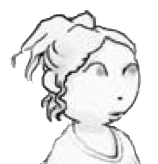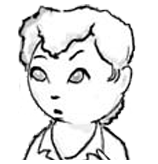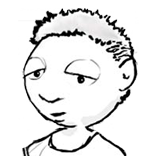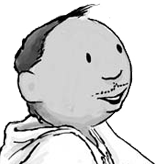Information about Copyright and Fair Use
Student Dialog - What is Copyright?
Lori : So are we ready to put this team project together?
 Sage : I am; I've got other assignments to finish before the semester is over.
Sage : I am; I've got other assignments to finish before the semester is over.
Deena : Me too. Let's get going.
 Brian : We've got all the basic information we need, but I think we could jazz up our presentation by having the students take a survey in class. I found a survey on line that we could use. You're supposed to pay for the surveys, but they cost $1.00 each. We can just make copies on my dad's copier.
Brian : We've got all the basic information we need, but I think we could jazz up our presentation by having the students take a survey in class. I found a survey on line that we could use. You're supposed to pay for the surveys, but they cost $1.00 each. We can just make copies on my dad's copier.
Jose : Let me see that.
Deena : I don't know guys, this sounds like stealing to me.
Sage : I'm with Deena. I think this is a copyright violation.
Lori : What's a copyright?
Sage : Whenever someone creates something, they own the "right" to it. Like if you write a poem, it's yours. No one else can say they wrote it, because you wrote it.
Lori : I get it. So the survey that Brian wants us to use belongs to its owner. Right?
Sage : Right! The way I see it, we have several options. We could buy the survey; ask for permission to copy the survey; or develop our own!
Brian : Gee guys, I didn't mean to get us in trouble. I just thought the survey would be a good way to get student attention in class—and a good grade!
Jose : No worries Brian. It is a good idea! We just can't use THAT survey. Let's develop our own!
Sage, Lori, Deena, Brian : OK, let's do!
A copyright gives the creator of an original creative work the exclusive right to control who can make copies of it, or make works derived from it (see reference 3). Even as a student, you have the right to control the use of your original creative projects and papers. Others who use your work must follow fair use guidelines or have your permission to use your work, and make a proper citation in the bibliography.
More information about copyright:
- http://www.templetons.com/brad/copymyths.html (10 Big Myths about Copyright Explained)
- https://copyright.psu.edu/copyright-for-psu-students/ (Copyright for PSU Students, information from the Office of Scholarly Communications and Copyright at PSU Libraries)
How are Copyright Laws and Plagiarism Related?
If you take someone else's work and put your name on it so others will think it is your original work, you are committing plagiarism, even if you paid for a legal copy of the materials. In addition, you are limited in the amount and nature of someone else's work you can use for presentations, projects, papers, and reports without asking for their permission, even when you give credit to the work's author/owner. Using more of someone else's work than "fair use" allows, without their permission, is a violation of copyright laws. It is possible to violate copyright laws without committing plagiarism and to commit plagiarism without violating the copyright laws, but both situations would be considered acts of academic dishonesty under Penn State's Academic Integrity policy.
What is Fair Use?
"Fair use" is a set of guidelines within the copyright law that allows for the limited use of copyrighted works without first obtaining the permission of the author or owner. These fair use guidelines make it possible for you to use parts of published works in projects, research papers, and reports you write for classes without violating copyright laws.
How can I tell if the use of a copyrighted work is fair?
When evaluating a particular use of copyrighted materials, consider the following four factors and ask yourself the following questions (see reference 4):
- The purpose and character of the use:
- Does the new work transform the original work or offer something beyond the original?
Copyrighted works that are altered significantly are more likely to be considered fair use. - Is the use for nonprofit or educational purposes?
Copyrighted works used for nonprofit or educational purposes are more likely to be considered fair use. - The nature of the copyrighted work:
- Is the copyrighted work published or unpublished?
Use of published works are more likely to be considered fair use. - Is the original work out of print?
Use of out of print works are more likely to be considered fair use. - Is the copyrighted work factual or creative?
Use of factual works are more likely to be considered fair use. - The amount and significance of the portion used in relation to the work as a whole:
- Is the amount of the original work used reasonable?
The smaller the percentage of the work used, the more likely it is to qualify as fair use. - Is the section of the original work used the most important part of the work?
The less significant the portion of the work used, the more likely it is to be considered fair use. - The effect of the use upon the potential market for or value of the work:
- Does the new work appeal to the same audience as the original work?
Copyrighted works that are used for another purpose or designed to appeal to a different audience are more likely to be considered fair use.
Even if something you use in a project, paper, or report qualifies as fair use, you still have to cite the source of the work to avoid committing plagiarism.
Fair Use Guidelines for Multimedia Projects
Allowed Uses
Many students like to make use of various forms of media, like images, recorded portions of television programs, digitized sound files, etc., in their projects and presentations. The Fair Use Guidelines For Educational Multimedia allow students who create educational multimedia projects containing copyrighted materials to use their projects for
- Educational uses in the course for which they were created.
- Portfolios as examples of their academic work.
- Personal uses such as job and graduate school interviews.
Students who create multimedia projects and follow the fair use guidelines do not have to request permission to retain a copy of their materials for their personal portfolio after completing their class or presentation. The guidelines require that all multimedia projects that include copyrighted materials:
- Credit the sources, display the copyright notice, and provide copyright ownership information. (The credit identifies the source of the work, including the author, title, publisher, and place and date of publication. The copyright ownership information includes the copyright notice, year of first publication, and name of the copyright holder.)
- State on the opening screen and on any accompanying print material a notice that certain materials are included under the fair use exemption of the U.S. Copyright Law and have been prepared according to the multimedia fair use guidelines and are restricted from further use.
- Clearly mark the materials as a student project with the specific class, date of the presentation or project, and complete university information.
- Do not contain materials that have been altered or separated from original content for reuse.
Storage
The fair use guidelines place restrictions on how the completed multimedia projects may be retained and stored.
- No more than two copies of a project may be made. One copy may be retained by the creator; the other must be held in the school's library or media center.
- Students may not make their own copies of copyrighted instructional materials used by instructors in class.
- Projects cannot be replicated or distributed for any purpose other than those listed in the guidelines without obtaining permission from all copyright owners.
Amount of Work You May Use
The guidelines also limit the amount of copyrighted multimedia material that can be included in educational projects to
- Up to three minutes or 10 percent, whichever is less, of a single copyrighted motion media work.
- Up to 10 percent or 1,000 words, whichever is less, of a single copyrighted work of text.
- An entire poem of less than 250 words or up to 250 words of a longer poem but no more than three poems by one poet or five poems by different poets from a single anthology.
- Up to 30 seconds or 10 percent, whichever is less, of music and lyrics from a single musical work.
- Up to five photographs or illustrations by one person and no more than 15 images or 10 percent, whichever is less, of the photographs or illustrations from a single published work.
- Up to 2,500 fields or cell entries or 10 percent, whichever is less, from a numerical database or data table.
A Note on Digital Media
The opportunities for inappropriate copying and use of copyrighted electronic material extend into media other than just text, including audio, video, graphics files, and even data sets. Even though digital files are readily available on the Internet, in most cases you must still have written permission before downloading or electronically copying and using someone else's electronic files (including music) for anything other than a project or presentation for a class. Also, when copying digital files, just as when copying any material, you must be very careful to follow the fair use guidelines as previously discussed.
Some Web sites may have a page listing circumstances in which a file could be downloaded and used (e.g. " for educational or non-commercial uses"). In these instances you may not have to follow fair use guidelines, but you still must give credit for the work by citing the author and/or Web site if you are using the materials for a project or paper. If you cannot determine whether your use of electronic materials is allowed, it is better to just not use them and create or find something else to use instead.
(see reference 5)
More Information about Fair Use
- Find copyright information about incorporating multimedia elements in projects and presentations in the Digital Storytelling guide, https://guides.libraries.psu.edu/digitalstorytelling (Penn State University Libraries, Library Guides)
- A Guide to Copyright, Fair Use, Creative Commons for students (Penn State University Library Learning Services).
What is a Public Domain Work?
A public domain work is a creative work that is not protected by copyright and which may be freely used by everyone. Creative works are placed in the public domain when:
- The term of copyright for the work has expired;
- The author failed to satisfy requirements to maintain the copyright or
- The work is a work of the U.S. Government.
Even if something that you use in a project, paper, or report is in the public domain, you still have to cite the source and author of the work to avoid committing plagiarism.
How do you know which Web resources you are allowed to use?
As a general rule, a good way to determine whether a Web site is copyright protected or in the public domain is to relate it as closely as possible to a print resource. Publications created by the U.S. government are in the public domain, for example, so information provided at U.S. government Web sites is also in the public domain.
Not every Internet resource can be related to a corresponding print resource, however. Erroneously posting copyrighted material to your own Web site carries even greater risks than innocently using copyrighted material in your class work. If you plan to post work you have not created to your Web site, you should avoid:
- Copying and posting links that contain descriptions of the linked sites, although posting links that contain only a URL and the title of the site is generally acceptable.
- Downloading graphics, including bullets, logos, fonts, photographs, and illustrations.
- Framing information from another site, particularly if you delete the site's ads or identifying information or make it look as if the information is your own.
- Deep-linking to an interior page of a site. Bypassing advertising or identifying information on a site's main page may deprive the copyright owner of revenue.
- Copying a site's html code.
You also should keep in mind that works posted on other sites might not have been posted by the copyright owner or with the copyright owner's permission. Just because a copyrighted work is already posted on the Web doesn't mean it's there legally. Even sites that have obtained the required permission may not have the right to transfer that permission to you. Always get permission to use a copyrighted online work from the owner of that work, not from a secondary source. If you plan to use the work online, be sure to get permission to use the work electronically. Print rights and electronic rights are not the same thing. (see reference 6)


